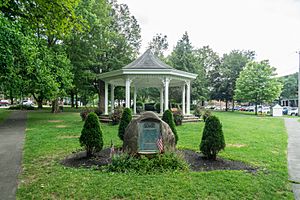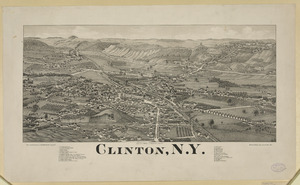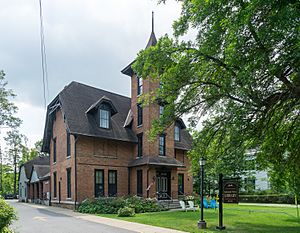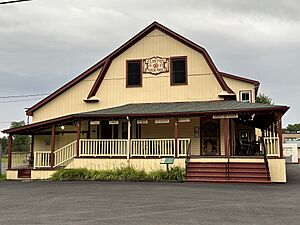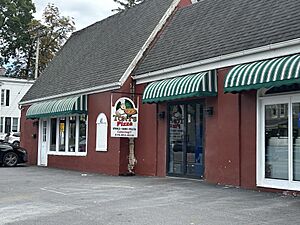Clinton, Oneida County, New York facts for kids
Quick facts for kids
Clinton, New York
|
|
|---|---|
|
Village
|
|
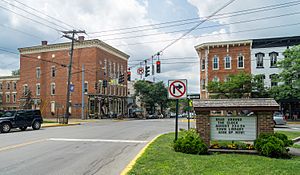
Center of Clinton, and starting point for street numbers, at College Street and West Park Row
|
|
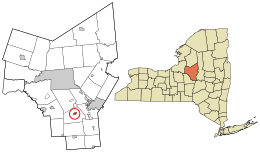
Location in Oneida County and the state of New York
|
|
| Country | United States |
| State | New York |
| County | Oneida |
| Area | |
| • Total | 0.63 sq mi (1.62 km2) |
| • Land | 0.63 sq mi (1.62 km2) |
| • Water | 0.00 sq mi (0.00 km2) |
| Elevation | 604 ft (184 m) |
| Population
(2020)
|
|
| • Total | 1,683 |
| • Density | 2,688.50/sq mi (1,038.27/km2) |
| Time zone | UTC-5 (Eastern (EST)) |
| • Summer (DST) | UTC-4 (EDT) |
| ZIP code |
13323
|
| Area code(s) | 315 |
| FIPS code | 36-16419 |
| GNIS feature ID | 0946885 |
Clinton is a small village located in Oneida County, New York, in the United States. Its name comes from George Clinton, who was the very first Governor of New York. The Seneca language name for the area is Ka-dah-wis-dag, which means "white field."
In 2020, about 1,683 people lived in Clinton. The village is part of the larger town of Kirkland. Clinton was once known as the "village of schools" because many private schools operated here in the 1800s. Hamilton College, a well-known university, is also very close to the village. People in the past described Clinton as a beautiful, healthy, and moral place, perfect for learning.
Contents
History of Clinton Village
Clinton started in March 1787 when soldiers from the Revolutionary War came from Plymouth, Connecticut. They found good soil, lots of trees, and friendly Oneida people in the area. The village was named after George Clinton, who was also the fourth Vice President of the United States.
Early on, Clinton grew as a farming and trading center. A gristmill, which grinds grain, was built on the Oriskany Creek in the first year.
Hamilton College's Beginnings
In 1793, a minister named Rev. Samuel Kirkland started the Hamilton-Oneida Academy. It was a school for both white and Oneida boys. Kirkland named it after Treasury Secretary Alexander Hamilton. This academy later became Hamilton College in 1812. This makes Hamilton College the third oldest college in New York, after Columbia and Union.
Clinton was first part of the Town of Whitestown, then the Town of Paris. In 1827, it became part of the new Town of Kirkland. Finally, in April 1843, Clinton officially became an independent village with its own local government.
In 1836, Clinton had about 50 homes, stores, taverns, and churches. It also had several schools.
Famous People from Clinton's Past
Elihu Root, a very important politician who served as Secretary of State and Secretary of War, was born in Clinton. He later won the Nobel Peace Prize.
Even though Clinton was not a big factory town, it had some industries. The Clinton Knitting Company made clothes, and the Clinton Canning Company processed local vegetables.
The famous pharmaceutical company Bristol-Myers Squibb actually started in Clinton in 1887. Its founders, William Bristol and John Myers, both studied at Hamilton College.
Notable People from Clinton
Many interesting people have connections to Clinton, New York:
- Natalie Babbitt: A children's author who won awards.
- Clara Barton: The founder of the American Red Cross, she studied here.
- Susan Bennett: The voice artist known for being the original female American voice of Apple's "Siri."
- William McLaren Bristol: One of the people who started Bristol-Myers Squibb.
- Grover Cleveland: A former US President who lived in Clinton as a child for two years. He attended the Clinton Grammar School.
- Rose Cleveland: Grover Cleveland's sister, who was the nation's first lady for two years. She taught history and literature in Clinton.
- Elihu Root: A US Senator and Secretary of War, born in Clinton. He won a Nobel Peace Prize.
- Bernie Sanders: Taught political science at Hamilton College in 1991. He later became a US Senator.
- B. F. Skinner: A famous psychologist.
- Leland Stanford: The founder of Stanford University, he studied briefly in Clinton.
- Hildegarde Swift: An award-winning children's author, born in Clinton.
Attractions and Fun Things to Do
The heart of Clinton is the Village Green, a park where many community events happen.
- Farmers Market: A summer market where you can buy fresh local goods.
- Shopper's Stroll: A special event after Thanksgiving for holiday shopping.
- Clinton Art and Music Festival: An annual festival in August celebrating art and music.
The Kirkland Art Center also has many activities all year. The historic Clinton Cider Mill on Elm Street has been making delicious cider since the early 1900s. It's open from Labor Day until Thanksgiving.
The Clinton Historic District is a special area listed on the National Register of Historic Places. This means its old buildings and history are protected. There is also a local Clinton Historical Society that helps preserve the village's past.
Education in Clinton
The Clinton Central School District serves students in Clinton and most of the surrounding town of Kirkland. Its main campus is located near the center of the village.
Hamilton College, a well-known four-year college, is right next to the village.
Clinton's School History
In the 1800s, Clinton was famous for its many schools. It was even called "Schooltown" or "an Academic village." The success of the Hamilton-Oneida Academy made Clinton a popular place for education. There were many private schools, both day schools and boarding schools, for different age groups. Some of these schools prepared students for college.
Before 1894, when New York State made school attendance required, about half of the children in town went to school. People in 1878 said that Clinton was a great place for education, helping to improve the community's morals.
- Hamilton-Oneida Academy: This school was the start of Hamilton College. It operated from 1793 to 1812.
- Clinton Grammar School: Founded in 1813, this school prepared students for college. Famous people like Elihu Root, Mark Hopkins, and Grover Cleveland studied here.
- Clinton Liberal Institute: This coeducational school was started by the Universalist Church in 1831. It taught many subjects, including Greek and French.
- Young Ladies' Domestic Seminary: Opened in 1833, this school for young women also welcomed students of all backgrounds, including African American and Native American girls. Students learned household skills along with their studies.
- Houghton Seminary: Founded in 1854, this school for young ladies was very successful. Its students could use the labs and library at Hamilton College.
By 1891, Clinton's public school began offering classes for all grades, from 1st to 12th. This reduced the need for so many private secondary schools.
Sports in Clinton
Clinton has a strong sports tradition, especially in hockey.
- Clinton Arena: This arena was once home to the Clinton Comets hockey team. Parts of the famous movie Slap Shot were filmed here.
- High School Hockey: The Clinton High School hockey team is one of the best in New York State. They have won state championships multiple times, including back-to-back wins in 1994-1995, 1995-1996, and again in 2004-2005, 2005-2006.
Other successful sports programs include:
- Cross Country: The team won back-to-back scholar athlete state championships in 2005 and 2006.
- Football: In 1984, the football team became Section 3 Class B Co-Champions.
- Boys' Soccer: The team won its first Section III title in 2006 and a second in 2011, reaching the state semi-finals. They are often top contenders in their conference.
- Track and Field: Clinton's track and field program is also well-known in the area.
Geography of Clinton
Clinton is located east of the Oriskany Creek. The village is known for a unique hill called The Knob. This hill is a type of landform called a kame, which is a mound of sand and gravel left behind by glaciers. In 1836, the owner of The Knob wanted to build an observatory there for the Clinton Liberal Institute, but this plan never happened.
Population Facts
| Historical population | |||
|---|---|---|---|
| Census | Pop. | %± | |
| 1870 | 1,640 | — | |
| 1880 | 1,236 | −24.6% | |
| 1890 | 1,269 | 2.7% | |
| 1900 | 1,340 | 5.6% | |
| 1910 | 1,236 | −7.8% | |
| 1920 | 1,270 | 2.8% | |
| 1930 | 1,475 | 16.1% | |
| 1940 | 1,478 | 0.2% | |
| 1950 | 1,630 | 10.3% | |
| 1960 | 1,855 | 13.8% | |
| 1970 | 2,271 | 22.4% | |
| 1980 | 2,107 | −7.2% | |
| 1990 | 2,238 | 6.2% | |
| 2000 | 1,952 | −12.8% | |
| 2010 | 1,942 | −0.5% | |
| 2020 | 1,683 | −13.3% | |
| U.S. Decennial Census | |||
In 2000, Clinton had 1,952 people living there. Most residents were White (98.05%). A small percentage were African American (0.61%) or Asian (0.72%). About 1.33% of the population identified as Hispanic or Latino.
The median age in the village was 43 years old. About 22.7% of the population was under 18. The average household had 2.11 people.
Economy
- Indium Corporation: This company, founded in 1934, works with metals. They refine, melt, manufacture, and supply various materials.
See also
 In Spanish: Clinton (condado de Oneida%2C Nueva York) para niños
In Spanish: Clinton (condado de Oneida%2C Nueva York) para niños


